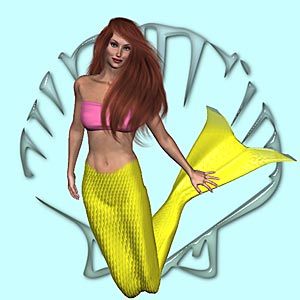
OK, TIME FOR SOME NAZI WERESHARKS!
Well, I never thought I’d do this, but here I am reviewing Peter Benchley’s Creature, originally published as White Shark, copyrighted in 1994 to OUR OLD NEMESIS. My copy says it exists in print under the auspices of St. Martin’s Paperbacks. That is just about par for the course. To my astonishment, the jacket also says it’s a Literary Guild Main Selection. This tells me a great deal about the standards of that august organization.
PLOT SUMMARY: Well, it’s the usual problem. A forgotten Nazi science experiment has broken out of its watery tomb and set about eating tourists in Connecticut. WHO YA GONNA CALL? There is only one man up to this task: Simon Chase of the Osprey Island Institute -- a struggling ecologist and shark fancier who has been trying to preserve the oceans from the depredations of his own species. His merry crew includes his 12-year-old son; Max’s girlfriend, a deaf telepath; an "ethnic interest" handyman; and an independently-wealthy pinniped specialist. Oh, and the housekeeper. WILL THEY PREVAIL??? After hearing this plot summary, DO YOU EVEN CARE???
>> What I noticed about this book, above all, was the way I kept referring back to Jaws as I read it. Simon Chase, the protagonist, is a combination of Sheriff Brody and Matt Hooper -- from the movie version, mind you. That makes Chase sort of a copy of a copy. Captain Quint and Ben Gardner are collapsed into a character named Rusty Puckett. The plot was almost identical to that of Jaws -- I was able to predict all the developments in the story pretty accurately based on the movie version of the author's biggest hit.
>> I have to start right out by saying this is an INCREDIBLY COOL IDEA. It's daring to think of human scientists trying to usurp OUR powers, pursue OUR grand project – sending humans back into the sea. Not unexpectedly, they do it for exactly the wrong reasons, and handle it in exactly the wrong way. They want their amphibious soldier to further petty monkey concerns AND CONQUER THE OCEAN at the same time, and that is JUST SILLY.
>> For the enlightenment of any landscum reading this, let me give you a news flash: YOU DON’T CONQUER THE OCEAN. THE OCEAN CONQUERS YOU.
>> I might as well tell you right now that I conform perfectly to the conspiracy-wide profile of operatives who have tried to read Benchley. I ate up Jaws (the book) only after I saw the movie. I was disappointed, but chose to persevere. I eagerly gulped down The Deep as quickly as I could afterwards, but I found it curiously flavorless, like a potato sorbet. Yes, even more flavorless than the novel Jaws! I quit halfway through Beast. I never tried Benchley again until now. After all this time, he STILL disappoints. That should give you an idea.
>> OK, back to the incredibly cool premise of this novel. Crossing a Great White Shark with a recreational killer who was actually kicked out of the SS for being too violent? Then losing it in the ocean? How could you go wrong with this story? BY HAVING PETER BENCHLEY WRITE IT. The man has no understanding of sharks. None. After reading this, I gather he has no understanding of Nazis, either. Or even oceanographers. I heard he used to write Presidential speeches for a living. That should tell you something right there.
>> The title character is a combination of Bruce the Shark and Freddy Kreuger, stainless-steel claws and all. There is also a faint whiff of Arnold Schwarzenegger’s character from the Terminator movies. Now, here's what asatounds me: Benchley actually managed to make the concept of a Nazi wereshark seem feasible. He pulled it off by barely sketching out the science of the project, and for that matter, by barely sketching out the Creature. He lets you fill in the (very large) gaps for yourself. Now, surely this was the hardest part of the novel, to convince me that this scientific screwup was possible. Could he not have gone on to make a few of the human characters believable?
>> The Nazi wereshark himself comes across very much as a big, lummoxy human with fins and gills. But, again -- astoundingly -- he character is convincing. This might be exactly what you WOULD get if someone went to work on this project. Dim mental process, impressive physical powers --especially for someone who was sewn together out of spare parts and then kept in suspended animation for 50 years! In order to appeal to the human reader, Benchley gives him a love of bloodshed, and allegiance to none.
>> This gives me a VERY disturbing mental picture of how the landscum imagine themselves living in our world. Possibly a good many citizens of the Planet Of The Apes would WANT to be operatives if they could change into, as they saw it, water-breathing serial killers. That makes a lot of sense when you consider how much footage in oceanographic documentaries is devoted to fish eating other fish. Of course, that is PURELY HUMAN THINKING that gets flushed out easily once the fish mind starts to overtake the monkey brain. But, still – ick!
>> As I’ve stated many times at the zone meetings, the type of hybrid described in this novel is not a LAND FISH, but a SEA MONKEY. This also applies to Ichthyander in The Amphibian Man, the Salmon/Soldier thingies in the remake of Humanoids From The Deep, and all analogues created by landscum science.
>> I shouldn’t even call the creature in this story a hybrid. He was sort of grafted together, adding spare fish parts to the stripped-down chassis of an SS officer. This book is a fine study in how human scientists ALWAYS BUNG IT UP. This Nazi medical genius apparently spent the whole war killing off hundreds of test subjects trying to create an amphibious soldier, and only produced a single working model.
>> I find it strikingly odd that a Nazi doctor was doing THIS experiment on Jewish prisoners. If he had succeeded, wouldn’t he have wound up with an army of insurgent Jew Fish, sinking German U-boats and recruiting Tuna and Giant Squid to join them in the fight against the Nazi genocide??? Hey, they might have made TERRIFIC agents for our side. We have never had as many Yiddish-speaking operatives as we would like.
>> I won’t belabor the advantages of OUR RECRUITING SYSTEM in comparison.
>> The only really 3-dimensional character in the novel is the unlucky slob who finally explains what’s been going on – an elderly Holocaust survivor who bought his escape from the concentration camps by volunteering to have gills sewn into his neck. You have to like HIM. We hear a little about what they put him through -- typical human scientific process. Broken bodies everywhere, no solid results for years. And then they drop the only successful experiment overboard. Oops! Write the story of THIS guy’s life, Petey, and I’ll buy it in hardcover. OK, I’ll buy it in trade paperback.
>> Using Nazis and Jews in this story made it much easier for Benchley to skew this into a story about the struggle between good and evil. What a multi-layered skin-crawler it is: if the Shark is a Nazi, he suggests, the Shark MUST be evil. Just a few years earlier, he wrote a story that made a plain, regular Shark look so evil that it set off a worldwide slaughter. Several key species have been nearly wiped out. Thanks, Petey! The assailants’ only justification is that they saw the movie version of Jaws. What is Benchley trying to do now, crank up the hostilities? What is the matter with this guy
?
>> One hint of our actual recruitment policy somehow slipped into the pages of this book. It is implied, though never stated, that this particular experiment succeeded because the SS officer had a natural Sharklike tendency. This is quite the interspecies slur, equating serial killers with Sharks, but since we never find anything else about the guy, we have no way of knowing whether he has actual Shark characteristics. It’s there if you want to read it that way.
>> The ending was, again, based on a great idea. The execution was only so-so. Typically for a landscum tale of the battle between good and evil, the author provided the hero with exactly the ponderous, clanking gadgetry needed to dispatch the menace at the crucial moment. But I had to read it three times to understand what happened. It was all far from clear.
A few comments about the movie version – a miniseries which I actually saw before reading the book:
>> They moved the story to the Caribbean, which allowed them to use endless footage of exotic island dances, including a spectacular Voodoo Shark Cotillion that was the highlight of the entire presentation. I have GOT to make that burlap Shark’s head for next Halloween.
>> They excised the whole Nazi thing, making the wereshark a recently-botched experiment by the U.S. Marine Corps. I found it amusing that the “White Shark” was made out of a Black Marine. And this one was apparently a true hybrid, not a spare-parts splice job.
>> This Shark had more authentic characteristics than the one in the book. But he could pop out arms and legs from under the fins, crawl out of the water, punch himself in the midsection, and thereby switch on his hidden lungs. Spiffy! This was a VERY nice-looking monster design, computer-generated of course, but for the most part pretty decent. Not too cartoonish. But, frankly, I thought he looked more like a Blue Shark than a Great White. Something about that smile.
>> If the design weren’t so obviously “off,” tipping our hand to potential new recruits AND to those who would stop us, I would want to see Shark operatives like these someday. Sharks who can just sort of press a button and switch back and forth from sea to land, then back again, would be pretty cool.
>> I’m sorry to say that the human characters have no more depth on the TV screen than they did in the book. They did add one zany Exposition Guy in the form of a character named Werewolf, who lives on the beach near the wereshark’s territory. He is keeping an eye on things, planning to take charge of the experiment comes ashore; it is unclear what he could do about it if anything did happen. Nervous tension has altered his personality to the point at which he is a little hard to take seriously. All the other characters were pretty much cardboard.
>> I tried an experiment on a dare by the operative who got this tape to me – I listened to the first half of the miniseries with the sound off. Sure enough, she was right – I knew exactly what was going on at all times, even without being able to follow the script. The landscum sure are predictable.















